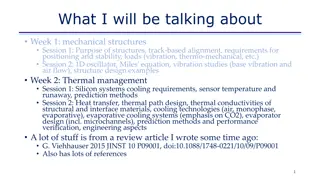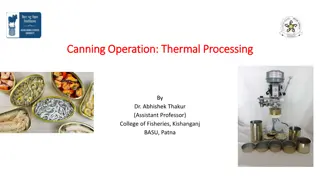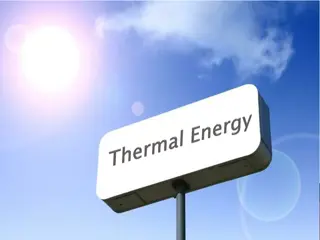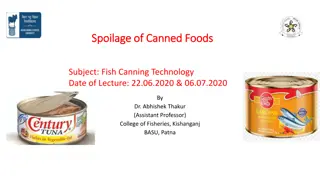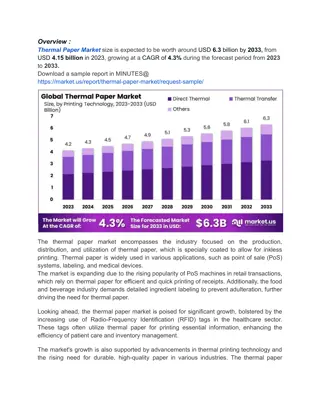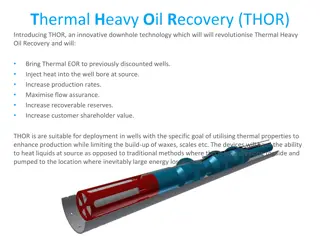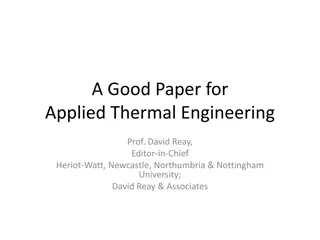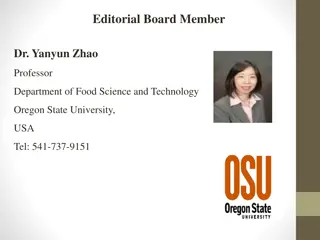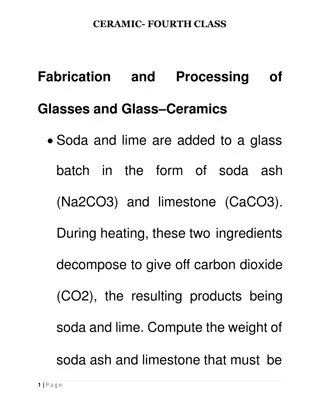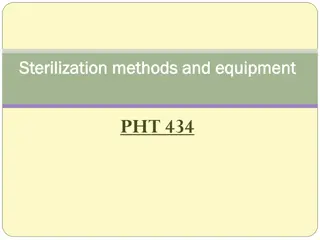Thermal Processing in Food Technology: Canning and More
Canning is a method of sealing and sterilizing food in containers for long-term storage. It involves processes like can filling, lacquering, syruping, brining, exhausting, processing, and cooling. Factors influencing heat penetration rates include product type, container size, and agitation. This detailed guide covers the key aspects of thermal processing in the food industry.
Download Presentation

Please find below an Image/Link to download the presentation.
The content on the website is provided AS IS for your information and personal use only. It may not be sold, licensed, or shared on other websites without obtaining consent from the author. Download presentation by click this link. If you encounter any issues during the download, it is possible that the publisher has removed the file from their server.
E N D
Presentation Transcript
CANNING AND OTHER METHODS OF THERMAL PROCESSING Department : Dairy Technology Course Title : Food Technology I Course No. : DTT -322 Course Teacher: Bipin Kumar Singh
Canning The process of sealing fruits and vegetables or any other foodstuffs hermetically (air tight) in containers and sterilizing them by heat for long storage is known as canning. In 1904, Nicholas Appert of France invented this process and he is called as Father of Canning . The process of canning is also known as Appertization.
Can filling Can filling is the process of aseptically filling whole or sized fruit or vegetables into the containers. The cans are washed with water or subjected to steam jet to remove any adhering dust or foreign matter. Tin metal thickness is about 0.25 mm. Thickness of coating varies from 0.31 mm to 1.54 mm.
Contd... Lacquering: The process of coating of inner side of the can to prevent discolouration of the product is called as lacquering. Lacquers include oleo-resinous material, synthetic resins, phenolic resins, epoxy resins and vinyl resins. There are two types of lacquers: (a) acid resistant and (b) sulphur resistant. Syruping and brining: In canning, syrups are added to fruits whereas brine (salt solution) is added to the vegetables. Purpose of adding syrups or brine is to improve the flavor, fill the space between the pieces of canned product and aid in the heat transfer during sterilization. Exhausting: Exhausting usually means heating the can and can contents before sealing. Sometimes it is may also refer to the treatment of the container under a mechanically produced vacuum. But in either case it is done to remove air from the can interior and prevent corrosion.
Contd.. Processing of the cans: The term processing as used in canning technology, means heating of canned foods (fruits, vegetables and other food stuffs) to inactivate bacteria. This is also called as retorting . Cooling: Immediately after processing, cans are cooled to room temperature in cold water bath or water tank. Once cooling is carried out, the outer surface is dried and labeled.
Rate of heat penetration in processing The important factors that influence the rate of heat penetration into a food are given below: Type of product : Liquid or particulate foods (for example peas in brine) in which natural convection currents are established heat transfers faster than in solid food in which heat is transferred by conduction (for example pastes or purees). The low thermal conductivity of foods is a major limitation to heat transfer in conduction. Size of the container: Heat penetration to the centre is faster in small containers than in large containers. Agitation of the container: End-over-end agitation and to a lesser extent, axial agitation increases the effectiveness of natural convection currents and thereby increases the rate of heat penetration in viscous or semi-solid foods (for example beans in tomato sauce).
Contd.. Temperature of the retort: A higher temperature difference between the food and the heating medium causes faster heat penetration. Shape of the container: Tall containers promote convection currents in convective heating. Type of container: Heat penetration is faster through metal than through glass or plastics owing to differences in their thermal conductivity.




